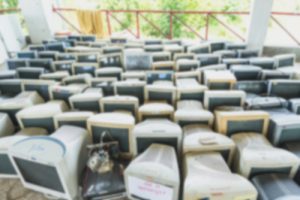 Markets and regulations are forcing companies active in the nation’s largest state electronics recycling program to landfill CRT glass. The move is legal, but it’s raising difficult questions for the many processors that have publicly vowed to avoid disposal.
Markets and regulations are forcing companies active in the nation’s largest state electronics recycling program to landfill CRT glass. The move is legal, but it’s raising difficult questions for the many processors that have publicly vowed to avoid disposal.
For instance, visitors to the website of processor e-Recycling of California are told that “leaded glass is refined to make new CRTs or is used as feedstock for closed loop recycling.”
But data from the state of California shows the company sent approximately 25 million pounds of CRT glass to landfill in 2016.
In an interview with E-Scrap News, Russ Caswell, general manager of e-Recycling of California, acknowledged the company is in a bind when it comes to communicating how it’s handling CRTs.
“It’s all being handled per state and federal rules, but if some portion of it is going to landfill, maybe we shouldn’t say recycling,” Caswell said. “We would absolutely prefer to be recycling it. I can tell you right now, if someone came up with a recycling option and the state approved it, we’d be all over it.”
Landfilling becomes the go-to option
Caswell’s company is far from the only processor in the state struggling to fulfill recycling promises due to CRT market realities.
Disposal of CRT glass has been allowed under the California program since 2015. Citing the lack of consistent and available downstream recycling outlets, regulators authorized the disposal of leaded glass in hazardous waste landfills and the disposal of panel glass in municipal solid waste landfills. The authorization was re-adopted last year and will run until September 2018.
Initial data from the state suggested about half of the 77 million pounds of CRT glass handled by state program companies in 2016 went to landfill. More detailed data obtained by E-Scrap News, however, shows at least 60 million pounds of the material – more than three-quarters of the total – headed directly to landfill.
For instance, ERI, one of the nation’s largest e-scrap firms, landfilled all of the nearly 8 million pounds of CRT glass it handled within the program in 2016.
In addition to ERI and e-Recycling of California, the following other e-scrap firms participating in the state program also landfilled at least half a million pounds of CRT glass last year, according to state data: ECS (18.8 million pounds), CEAR (2.7 million pounds), IMS (2.5 million pounds), PC Recycle (1.8 million pounds) and Onsite Electronics (just over 619,000 pounds).
However, all the companies listed above have included language in online marketing materials that strongly suggests disposal is either banned or avoided, according to an E-Scrap News analysis.
ERI’s website notes, “ERI is committed to ensuring no part of your device ends up in a landfill or is exported abroad, and holds it partners to the same standards.” And the ECS website states the company offers “the most sophisticated, full-circle recycling process in the world” to handle CRTs.
Before being contacted by E-Scrap News for this story, the sites for both ERI and ECS used more direct language, with ERI noting a “strict zero-landfill, zero-export policy” and ECS stating that electronics are recycled “instead of being dumped in a landfill or shipped overseas.” But that verbiage has since been removed.
Meanwhile, California Electronic Asset Recovery (CEAR) states it is “fully pledged to a zero landfill policy.”
IMS warns of the “astronomical” and “lethal” ramifications of landfilling. PC Recycle states that the company’s “first priority” is keeping electronics out of landfills. And Onsite Electronics states, “We properly dismantle and recycle all materials.”
Companies say their hands are tied
Executives from those companies that could be reached for comment echoed the sentiments of Caswell, noting that the landfill is their only viable option right now.
In a statement, ERI co-founder Aaron Blum said, “Our ability to divert material away from a landfill is not always a decision we get to make.” Blum, who is also the company’s chief compliance officer, added the company has a “zero landfill mission” and noted 95 percent of the material ERI receives nationwide gets recycled. The company also noted all of its landfilled material goes to hazardous waste sites.
While ECS managed to find a smelter in South Korea called Korea Zinc for its leaded glass late last year, the company continues to landfill panel glass in California, according to state figures. Ken Taggart, executive vice president at ECS, said in a statement that regulatory restrictions are to blame.
“ECS maximizes recycling and maintains a landfill-avoidance policy for all residuals that can be legally recycled, and for which there is the technology, demand and capacity,” Taggart stated.
Paul Gao, CEAR’s owner, meanwhile, said “zero landfill” is an aspirational goal for his company. “Our policy or our goal is toward 100 percent recycling and right now we explain to customers we’re achieving 95 percent,” Gao said. “That’s all we can do right now.”
IMS, PC Recycle and Onsite did not respond to numerous requests for comment for this article.
Slim spectrum of choices
The squeeze on processors is being driven by the fact that the only avenues for actually recycling California glass have dried up.
Under California law, leaded CRT glass can only be recycled in one of two ways: as part of a glass-to-glass manufacturing process or at a lead smelter. This eliminates using leaded CRT glass in other products, such as tiles. Non-leaded glass, meanwhile, is allowed to be recycled into a variety of applications, such as tiles, fiberglass, bricks and radiation shielding glass, but doing so is not easy under current state regulations.
Leaders at companies handling glass in California say that this spectrum of choices allowed by the state is extraordinarily slim. Access to glass-to-glass manufacturing dried up entirely last year, which has affected the entire glass recycling industry in the U.S. California is also at a geographic disadvantage when it comes to utilizing the two most popular North American lead smelters of CRT glass, Doe Run in Missouri and Glencore in New Brunswick. What’s more, companies said demand from smelters has fallen off in recent years.
“In our minds, there’s really no option other than going to landfill,” said Caswell of e-Recycling of California. “We don’t write the regulations; we just follow them.”
Glass-to-glass and smelting outlets in 2016 received roughly 9.5 million pounds of CRT glass from California, according to state records. That’s about 12 percent of the 77 million pounds of CRT glass managed during the year.
India-based CRT manufacturer Videocon received about 6.5 million pounds of glass before its closure. Smelters Doe Run, Glencore and Korea Zinc received the rest of the material.
Continuing to look for possibilities
Jeff Hunts, who manages the California Department of Resources Recycling and Recovery’s (CalRecycle) e-scrap program, said “the vast majority” of CRT glass continues to head to landfill in the state.
He also acknowledged that recycling solutions are hard to find.
“California regulations severely limit market options for CRT glass,” Hunts said. “We should continue to look for recycling possibilities that are protective of the public and the environment as long as this waste stream lasts.”
ERI’s Blum said stakeholders are trying to solve the issue.
“We are working closely with the state of California to expand the available downstream recycling options for CRT glass,” Blum stated. ECS’s Taggart said his firm was also actively working with stakeholders and hoped regulations would become more “pro-recycling” in the future to open up more downstream outlets for the material.
How should companies publicly talk about their actions until such options appear? While acknowledging the lack of options for California firms, one trade association representative suggests just being open and honest.
“If I were a recycler and I was disposing of the material in a landfill … I would just come clean,” said Billy Johnson, chief lobbyist for the Institute of Scrap Recycling Industries (ISRI). “[Otherwise], it’s a recipe for disaster.”



